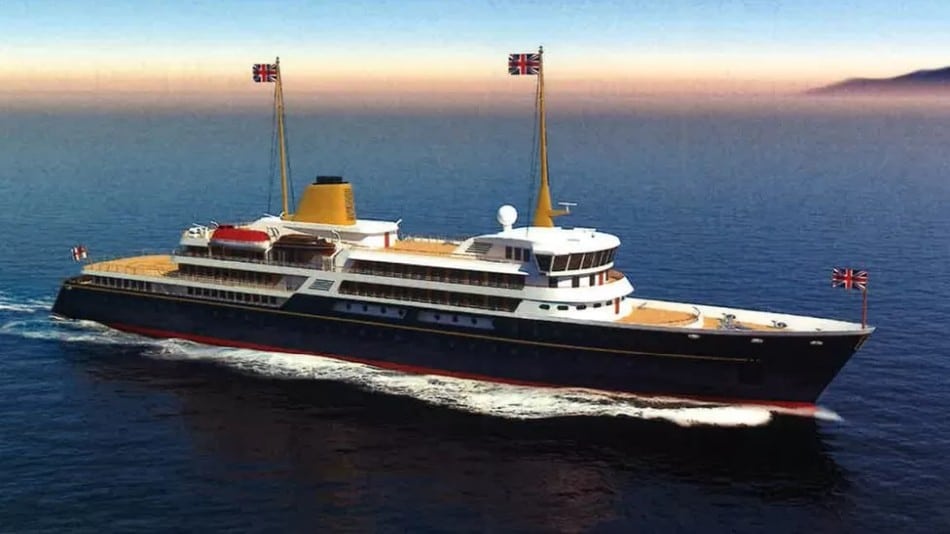Defense Secretary Ben Wallace announced that plans to build a new yacht to promote Britain in the seas and oceans have gone trash, most likely once and for all. A £ 250m tender to select a company to build the vessel was canceled. The name for the new unit has not been selected (and if selected, not announced). British media reported that it was planned to be named after Prince Philip, husband of Queen Elizabeth II, who died last year, but the royal family opposed it.
The new yacht was to be the successor of the royal yacht HMY Britannia, decommissioned in 1997. In practice, however, it was to play a different role. Instead of carrying the king and his relatives (Britannia, for forty-four years of service, made nearly 700 cruises as part of the official journeys of foreign members of the royal family), the main purpose of the vessel was to host fairs and diplomatic meetings on board. In press releases, it was even referred to as “the floating embassy”.
Nevertheless, it is likely that the new yacht would function in a similar way to the Britannia: it would be manned by Royal Navy sailors volunteering first for a one-year service turn and then possibly taking up regular service as Royal Yachtsmen. The Royal Marines would most likely be responsible for the protection of the unit beyond the home waters. According to preliminary assumptions, the crew was to be 50-60 people.
The “national flagship” project was the apple of the apple of former Prime Minister Boris Johnson’s eye. Hence, observers of the British political scene assumed that the new yacht, in keeping with Johnson’s ambitions, would play the role of Britannia wherever possible, and especially as a symbol of British power in line with Thomson’s Rule, Britannia! rule the waves. However, the government emphasized that it would not be a luxury yacht, but a vessel designed to perform practical tasks without unnecessary pomp.
HMY Britannia, Canada in 1959.
(Canada. Dept. of National Defense / Library and Archives Canada)
However, two changes to the prime minister’s position have passed and the current head of government, Rishi Sunak, decided that it was impossible to justify spending a quarter of a billion pounds (over PLN 1.3 billion) on a unit that is not expected to bring any tangible benefits. And it is certainly impossible to justify such an expense now, when the government is looking for all possible savings before the so-called autumn statement, which is the presentation in Parliament of the budget and the state of the British economy, scheduled for November 17.
Initially, in May 2021, the new yacht was expected to cost £ 150 million, but the cost estimate quickly began to bulge and Wallace had to admit last year that the £ 200 million threshold had been reached. The annual cost of living was estimated at £ 20-30 million. The vessel was planned to fly its flag in 2024 or 2025. Wallace had recently called it the jewel in the crown of the government’s shipbuilding strategy.
– I want future grandparents to boast to their grandchildren one day: “I helped build this ship” – he said in July last year.
Instead of the “new Britannia”, London will focus on accelerating work on new research and reconnaissance ships Multi-Role Ocean Surveillance Ships (MROSS). Wallace stressed in a speech to the House of Commons that the acquisition had grown in importance in view of the ongoing Russian invasion of Ukraine and the growing threat to undersea infrastructure. MROSS will help in securing it. The first ship should enter service with the Royal Fleet Auxiliary in 2024.
. @ HarlandWolffplc has released images of its design (one of two finalists) for the National Flagship competition which was officially canceled today. @ BWallaceMP told Parliament the Multi Role Ocean Surveillance Ship (MROSS) project will be prioritized instead. pic.twitter.com/EMJTo2KGRB
– Navy Lookout (@NavyLookout) November 7, 2022
Caution is advised in this matter, as we have recently been strongly reminded of by leaks from the Nord Stream pipelines, most likely caused by Russian sabotage. However, Moscow’s interest in underwater sabotage, especially in the telecommunications infrastructure, has a long tradition. In this context, we have mentioned many times about the peculiar flagship of the Russian Main Deep Sea Research Board. The 108-meter Jantar of the 22010 Kriujs project, classified as an oceanographic vessel, is in practice, however, a reconnaissance vessel, with a rich two-purpose apparatus – military and civil – and capable of searching for objects on the seabed. It is equipped with two large autonomous underwater vehicles, capable of taking high-resolution photos of the seabed and undersea infrastructure, and of picking up objects from the seabed. Certainly cutting the cable does not exceed their capacity.
So far, little information about the MROSS has been released, but it is known that two ships will be built, the first of which will be based on an already existing and proven civilian design, while the second will be built in the UK according to a design developed from scratch for this program . Therefore, it is difficult to talk about the MROSS type, it will rather be a class of ships composed of two types represented by single ships. The common feature is the relatively small size and high degree of automation, thanks to which each unit is to be manned by a crew of only about fifteen people.
See also: Nigeria has bought Turkish T129 helicopters

